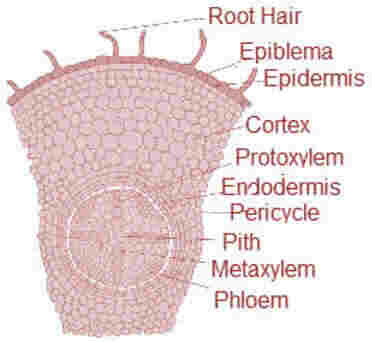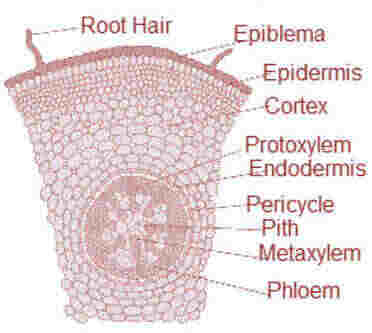Anatomy - Dicot roots and Monocot Roots
Anatomy of Dicotyledonous Root
The transverse section of the dicotyledonous root. The internal tissue organisation is as follows:
The outermost layer is epiblema. Many of the cells of epiblema protrude in the form of unicellular root hairs.
The cortex consists of several layers of thin-walled parenchyma cells having various types of vascular bundles :
- radial
- conjoint closed
- conjoint open

The innermost layer of the cortex is called endodermis. It comprises a single layer of barrel-shaped cells without any intercellular spaces. The tangential as well as radial walls of the endodermal cells have a deposition of water-impermeable, waxy material suberin in the form of casparian strips.
And next to endodermis lies a few layers of thick-walled parenchyomatous cells referred to as pericycle.
Initiation of lateral roots and vascular cambium during the secondary growth takes place in these cells.
The pith is small or inconspicuous.
The parenchymatous cells which lie between the xylem and the phloem are called conjuctive tissue.
There are usually two to four xylem and phloem patches. Later a cambium ring develops between the xylem and phloem.
All tissues on the innerside of the endodermis such as pericycle, vascular bundles and pith constitute the stele.
Monocotyledonous Root
The anatomy of the monocot root is similar to the dicot root in many respects. It has epidermis, cortex, endodermis, pericycle, vascular bundles and pith.
As compared to the dicot root which have fewer xylem bundles, there are usually more thansix (polyarch) xylem bundles in the monocot root.
Pith is large and well developed. Monocotyledonous roots do not undergo any secondary growth.

The Difference between Monocotyledonous and Dicotyledonous Roots
| Basis | Monocot Root | Dicot Root |
|---|---|---|
| Cortex Area | The cortex area is wide. | The cortex area is narrow. |
| Pericycle | It gives rise to just lateral roots. | It gives rise to cork cambium, lateral roots and parts of the vascular cambium |
| Cambium | It is absent. | It is present and formed due to the conjunctive parenchyma. |
| Secondary Growth | Secondary growth is absent. | Secondary growth takes place to support vascular cambium and cork. |
| Vascular Tissues | More numbers of Xylem and Phloem. | Less number of Xylem and Phloem. |
| Shape of Xylem | Round or oval shape. | Angular or polygonal shape. |
| Pith | It has a well-developed pith. | The pith is absent or very small. |
| Number of Xylem and Phloem | May be more than 8. | The number varies from 2-8. |
